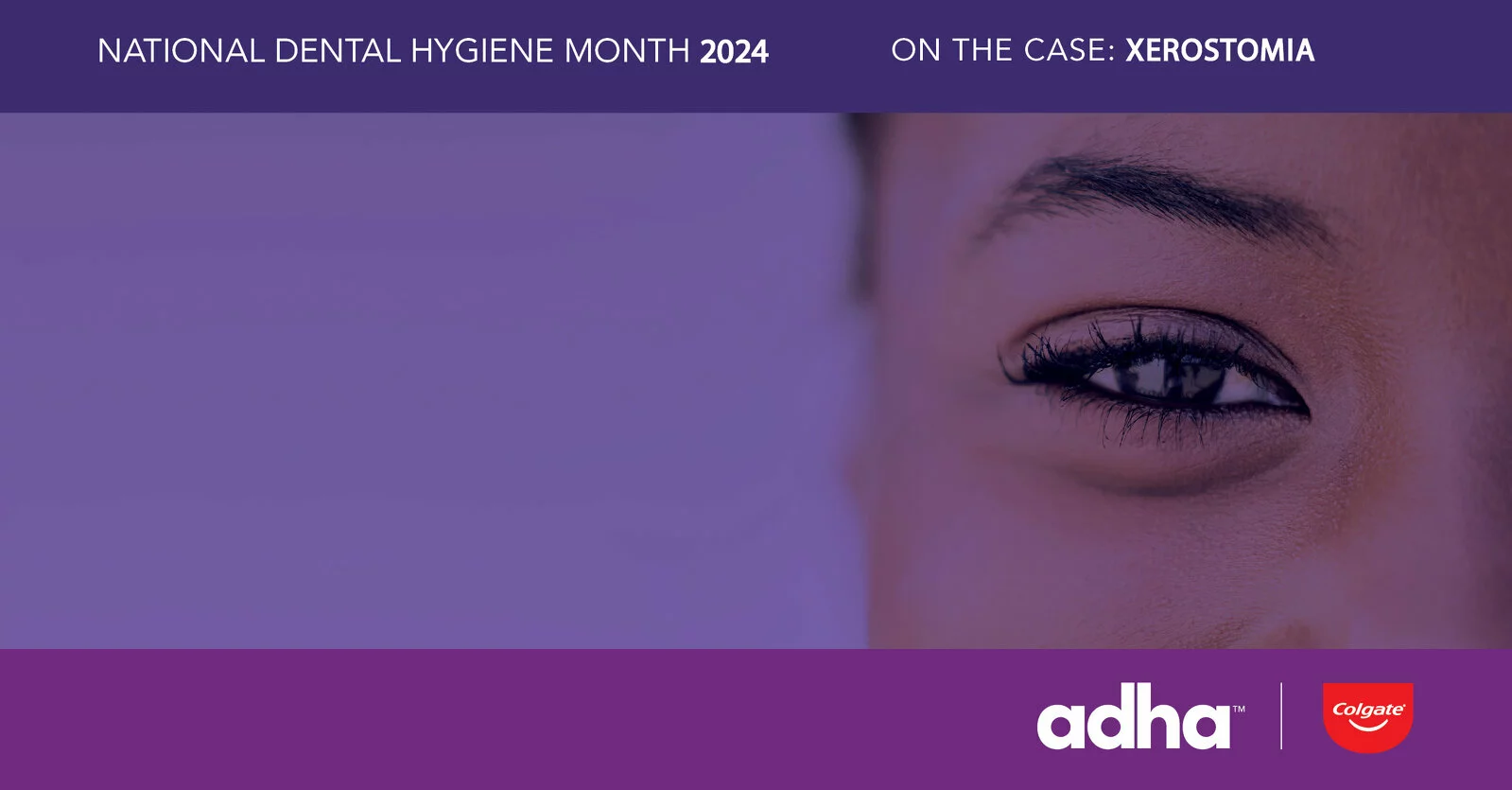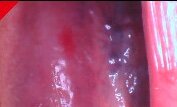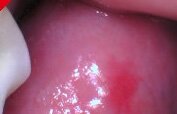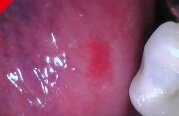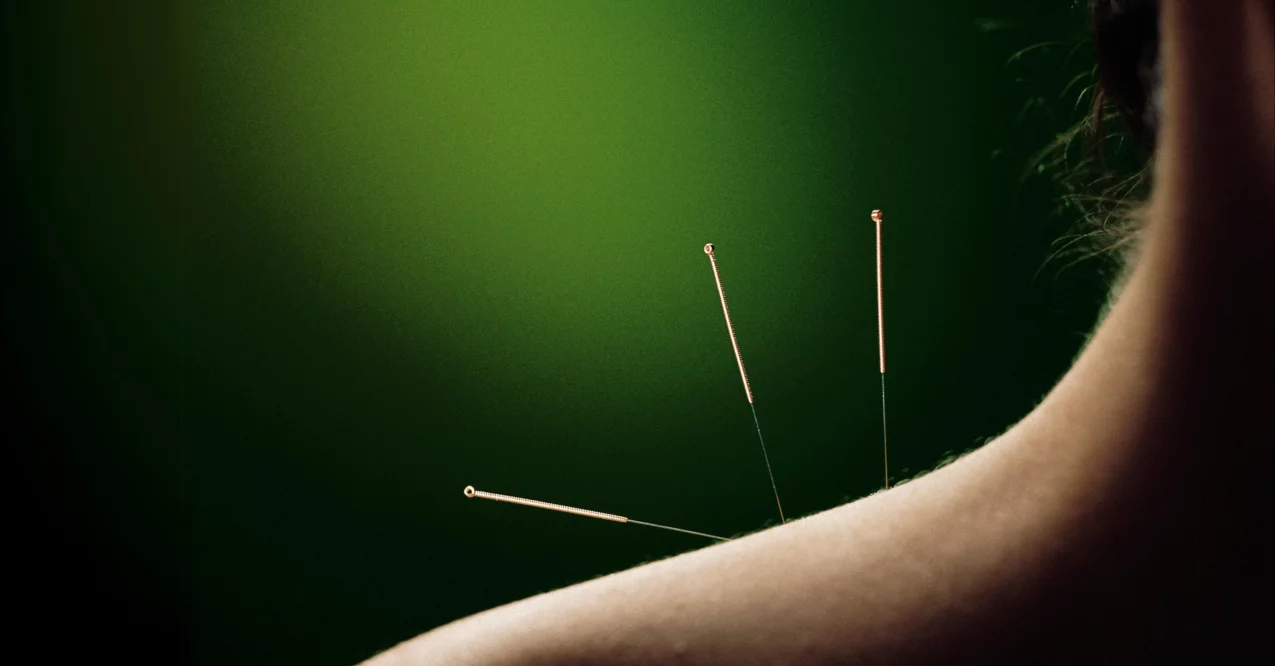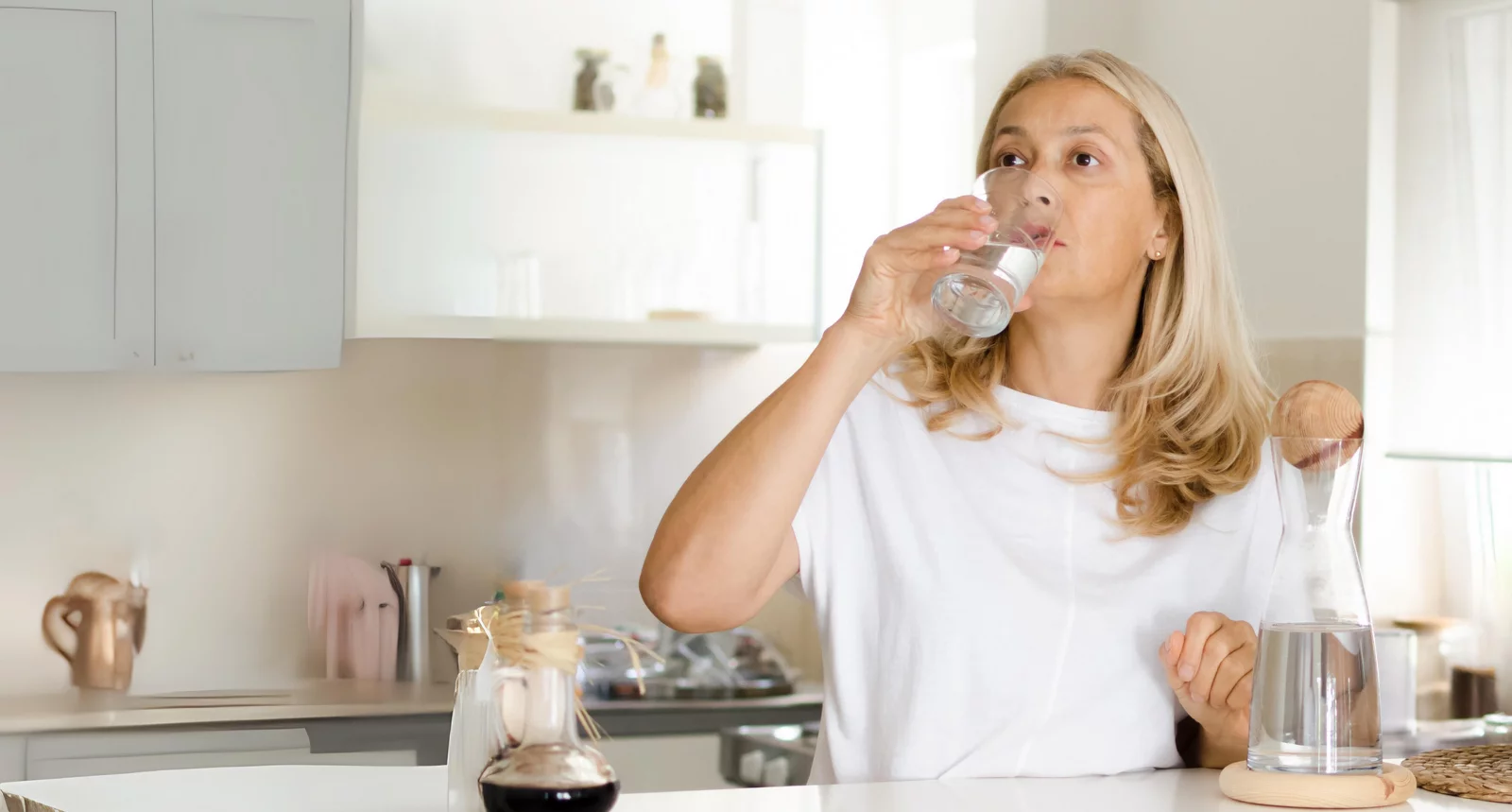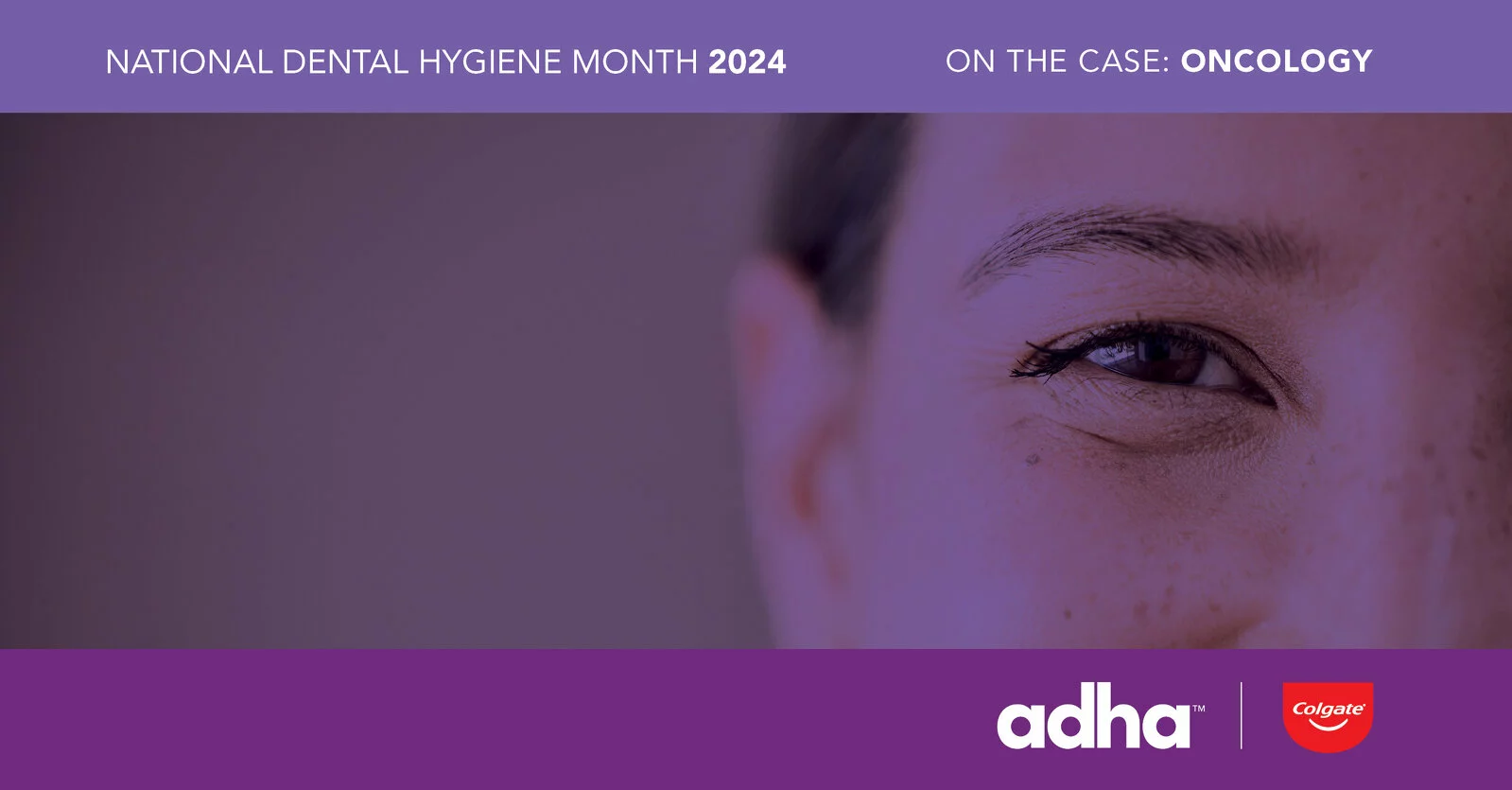by Michelle C. Arnett, MS, RDH, and Yvette Reibel, EdD, LDH
October 21, 2024
This case has been prepared for publication during National Dental Hygiene Month 2024. The content is revealed as clues in email and on social media, with the full clues, case and care presented here. The case follows the ADHA Standards for Clinical Dental Hygiene Practice and incorporates a clinically supported solution from Colgate.
Initial Clues and Assessment
An 84-year-old male patient presented for a routine prophylaxis. Examination and clinical assessments reveal a new oral lesion and increased bleeding upon probing.
Patient History
The patient is retired, and has been a patient of the clinic since 2021. The patient does not have dental insurance coverage and pays out of pocket for all dental care. The patient’s medical and dental history included hypertension treated with 25 mg hydrochlorothiazide (HCTZ) and 100 mg losartan, hypercholesterolemia controlled with 20 mg pravastatin, anxiety using diazepam as needed, and obstructive sleep apnea (OSA) using continuous positive airway pressure (CPAP) treatment. The patient also disclosed gastrointestinal reflux not using medication currently, bilateral knee replacement with no prophylaxis indicated, cataract eye surgery in the right eye, and hearing loss resulting in the use of hearing aids. The patient’s chief complaint is obtaining a refill for whitening trays.
Current patient homecare routine: Patient reported brushing twice a day with an electric toothbrush and flossing daily. No other adjuncts were reported by the patient.
In a 2023 dental hygiene visit, clinical findings were moderate generalized plaque, light bleeding upon probing (10%), clinical attachment loss of 5mm throughout, Class 2 furcation on teeth #18, 19, 30, and 31. The patient was classified with periodontitis localized Stage III Grade B, stable. Patient remarks about having a dry mouth from the CPAP machine.
In a 2024 routine dental hygiene visit, clinical periodontal findings worsened, and bleeding increased by 5%, increased calculus present, gingival observations described gingival tissues are erythematous and edematous. During the clinical examination two oral lesions that were 3mm x 5mm red, flat with irregular borders were located on the soft palate and tongue. A dentist was consulted regarding the present lesions, and the diagnosis is CPAP related traumatic lesions. It was recommended the patient return to the clinic for a 6-week re-evaluation of the lesions to determine if a referral for an oral pathology consultation is required.
- Tongue, Intraoral Image Left Side
- Soft Palate Intraoral Image
- Tongue, Intraoral Image Left Side
Diagnosis
Clues to inspire diagnosis and knowledge application to formulate the differential diagnosis for the xerostomia and oral lesions included 1) medication-induced xerostomia, 2) xerostomia from OSA and CPAP use, 3) xerostomia caused by dehydration, and 4) oral lesions related to xerostomia and trauma from CPAP use.
Clues
- What factors contribute to xerostomia?
- How does xerostomia impact periodontal hard and soft structures?
- What factors contribute to the oral lesions on the soft palate and tongue?
- What comorbidities are associated with OSA?
Dental Hygiene Diagnosis
84-year-old male with poor plaque biofilm control, high blood pressure, high cholesterol, OSA with CPAP use, and Stage III Grade B periodontitis.
Planning
Obstructive sleep apnea is the most common sleep disorder in the United States (U.S.) with over 80% of the sleep-disorder breathing cases.1 OSA is characterized by the recurrent narrowing or collapse of the upper airway during sleep.1,2 This results in partial or complete cessation of airflow, despite continued respiratory effort.1 OSA can be potentially dangerous if left untreated.2 Sleep apnea can lead to excessive daytime sleepiness, impaired cognitive function, dementia, depression, type 2 diabetes, cardiovascular disease, hypertension, heart failure, and ischemic stroke.1,2 Risk factors for sleep apnea include large tonsils, obesity, male, older age, enlarged neck circumference, narrowing of the upper airway, high arched palate, and nasal obstruction.1-3
OSA can be managed with a continuous positive airway pressure (CPAP) machine that can be worn during sleep.4 The machine uses mild air pressure to keep breathing airways open while one sleeps.4 The CPAP machine includes a mask that can fit over the nose or the nose and mouth.4 Attached to the mask are straps that secure the mask and then a tube that connects the mask to the machine’s motor.4 The motor of the machine is the aspect that blows air into the tube.4 The CPAP machine can help with better sleep, reduction in snoring, and less daytime sleepiness.4,5 For long-term use, the CPAP can reduce risk of a stroke, control or prevent hypertension, and overall improve cognitive function.4,5 Some side effects of the CPAP machine may include congestion, dry mouth, rhinitis, nosebleeds, and stomach discomfort.4 However, these symptoms can be relieved with a consultation with a healthcare provider by adjusting the CPAP machine as needed.4
Dry mouth is prevalent in individuals with OSA that use a CPAP machine.6 Those who report dry mouth with CPAP use often report poorer sleep quality and may defer from using the CPAP machine.6 Dry mouth is an oral manifestation that can cause increase risk for dental caries, traumatic oral lesions, oral infections, plaque accumulation, gingivitis, and periodontitis.7 Some recent research supports that OSA is associated to periodontitis.8 There is evidence that the same inflammatory mediators that play a role in the pathogenesis of OSA are also associated with periodontitis.9 Both diseases also share the same common risk factors including obesity, male, ethnicity prevalence in African Americans, and older age.1-3,9 Therefore, OSA is a condition that should be taken into consideration as a dental hygienist as evidence suggests that it is a systemic condition where oral implications may need to be addressed through collaborative intervention.
Through clinical assessments it was noted that the patient has had sleep apnea for many years. The patient reported that they have never received new supplies for their CPAP machine, they do not use the humidifier, and they have never cleaned their machine. The patient also reported dry mouth. These details were revealed during the limited exam by the dentist. The dentist recommended monitoring the tongue and soft palate lesions, cleaning the CPAP machine, using a humidifier, and follow-up with a physician on the fit of the CPAP machine. These suggestions align with National Heart, Lung, and Blood Institute (NHLBI) for maintenance of the CPAP machine. It is recommended that the machine is used with a humidifier chamber.4
It is also recommended for the therapy to work to clean the mask and tube every day and refill the medical device prescription at the right time to replace the mask and tube.4 If the machine is not properly maintained or adjusted as needed, the therapy may not work properly. This may lead to therapy to not work at all, which may lead to disrupted sleep and dry mouth.1,2
Prognosis: Good with proper dental home care and maintenance of CPAP.
Implementation
The treatment plan included patient education regarding dry mouth, review of CPAP care and maintenance, importance of having the CPAP fit examined since it has been at least a decade since the device has been delivered. Also educated the patient on following up with their sleep medicine provider on replenishing CPAP supplies and the importance of using the humidifier features. Home care recommendations could include a powered toothbrush, like Colgate® Hum with the app tracking, to decrease the amount of plaque biofilm present thus resulting in reduced bleeding present. Another recommendation is to use floss twice daily and the patient could benefit from using Colgate® Total Plaque Pro-Release, and Colgate® Prevident to decrease caries risk due to dry mouth. Additionally, Colgate® Peroxyl can be recommended for any discomfort the patient experiences with the healing lesions.
____________________________________

Patients of all ages can experience dry mouth. Colgate® PreviDent® 5000 ppm Dry Mouth (1.1% Sodium Fluoride) toothpaste protects patients at high risk of caries
– Clinically proven fluoride technology
– Unique liquid gel formula enables faster fluoride dispersion than paste-form Rx toothpaste1
– Soothing mint flavor formulated to appeal to dry mouth sufferers
– SLS-free formula
To order contact your Colgate Territory Manager or call 1-800-2COLGATE (1-800-226-5428) Monday – Thursday (7:30 am – 5:30 pm CST) Friday (7:30 am – 4:30 pm CST) to speak to a customer service specialist.
References: 1. Joziak MT, et al. Comparison of enamel fluoride uptake and fluoride release from liquid and paste dentifrice. J Dent Res. 2003; 82 (Sp Issue). Abstract 1355. Important Safety Information: PreviDent® 5000 ppm Dry Mouth Toothpaste: Do not swallow. Keep out of reach of children. Acute burning in the mouth and sore tongue may be experienced by some individuals. If accidental ingestion occurs, side effects may include nausea, vomiting, diarrhea, and abdominal pain. See Package Insert for additional safety information.
STATUTORY PRICE DISCLOSURE FOR COLORADO PRESCRIBERS: In accordance with the Colorado Wholesale Acquisition Cost Disclosure Law (Colorado Revised Statutes Section 12-42.5-308), Colgate Oral Pharmaceuticals, Inc. is disclosing to you, as an authorized prescriber of prescription drugs in Colorado, certain required pricing information for Colgate Oral Pharmaceuticals, Inc. marketed prescription drugs. Please visit this webpage to access this price disclosure information.
STATUTORY PRICE DISCLOSURE FOR CONNECTICUT PRESCRIBERS: In accordance with the Connecticut Public Act No. 23-171, Colgate Oral Pharmaceuticals, Inc. is disclosing to you, as an authorized prescriber of prescription drugs in Connecticut, certain required pricing information for Colgate Oral Pharmaceuticals, Inc. marketed prescription drugs. Please visit this webpage to access this price disclosure information.
____________________________________
Evaluation
A 6-week re-evaluation of the traumatic lesions will occur to determine if a referral for an oral pathology consultation is recommended due to not resolving. Evaluation of oral hygiene behaviors (brushing and flossing) will be measured by patient’s self-report of frequency of compliance, plaque index and BOP. Additional evaluation will include the cleaning and fit of the CPAP machine at regular dental visits. Assess the comfort the patient reports with dry mouth and determine if additional products should be recommended. Caries and periodontal risk assessments should be completed at regular intervals to assess the need for adjunctive preventative strategies in the progression of caries and periodontitis.
Documentation
Documentation included patient consent for routine dental care, intraoral images of lesions, limited exam findings included a diagnosis of the lesions to include CPAP related traumatic lesion, and OHI. Future documentation needs to include periodontal disease progression measured by annual radiographs, periodontal examination, plaque index, patient oral hygiene and periodontal maintenance compliance. Documentation of the clinician’s future care includes 3-month periodontal maintenance, continued twice daily brushing and flossing, cleaning CPAP machine, using the humidifier feature on the CPAP, and ordering replacement supplies.
____________________________________
Article References
1 Sleep Apnea (Obstructive) [Internet]. American Dental Association; c2020. Sleep apnea. [cited on 2024 May 27];[about 1-3 screens]. Available from: https://www.ada.org/en/resources/ada-library/oral-health-topics/sleep-apnea-obstructive
2 Javaheri S, Barbe F, Campos-Rodriguez F, et al. Sleep Apnea: Types, Mechanisms, and Clinical Cardiovascular Consequences. J Am Coll Cardiol. 2017 Feb 21;69(7):841-58.
3 Zhang W, Phillips A, Wang BY. Correlation Analysis between Airway Volume and Risk of Sleep Apnea/Periodontitis. J Oral Maxillofac Res. 2022 Jun 30;13(2):5.
4 CPAP [Internet]. National Heart, Lung, and Blood Institute; c2022. CPAP. 2022 Mar 24.[cited on 2024 May 27];[about 1-2 screens]. Available from: https://www.nhlbi.nih.gov/health/cpap#:~:text=CPAP%20(continuous%20positive%20airway%20pressure,breathing%20disorders%20including%20sleep%20apnea.
5 Avlonitou, E., Kapsimalis, F., Varouchakis, G. et al. Adherence to CPAP therapy improves quality of life and reduces symptoms among obstructive sleep apnea syndrome patients. Sleep Breath 2012;(16): 563–69.
6 Pico-Orozco J, Carrasco-Llatas M, Silvestre FJ, et al. Xerostomia in patients with sleep apnea-hypopnea syndrome: A prospective case-control study. J Clin Exp Dent. 2020 Aug 1;12(8):708-12.
7 Xerostomia (dry mouth)[Internet]. American Dental Association; c2020. Xerostomia (drymouth). [cited on 2024 May 27];[about 1-2 screens]. Available from: https://www.ada.org/en/resources/ada-library/oral-health-topics/xerostomia#:~:text=In%20patients%20with%20xerostomia%20or,may%20appear%20dry%20and%20fissured.&text=Patients%20may%20commonly%20have%20dental,gingivitis%2C%20and%2For%20periodontitis.
8 Khodadadi N, Khodadadi M, Zamani M. Is periodontitis associated with obstructive sleep apnea? A systematic review and meta-analysis. J Clin Exp Dent. 2022 Apr 1;14(4):359-365.
9 Al-Jewair TS, Al-Jasser R, Almas K. Periodontitis and obstructive sleep apnea’s bidirectional relationship: a systematic review and meta-analysis. Sleep Breath. 2015 Dec;19(4):1111-20.
____________________________________
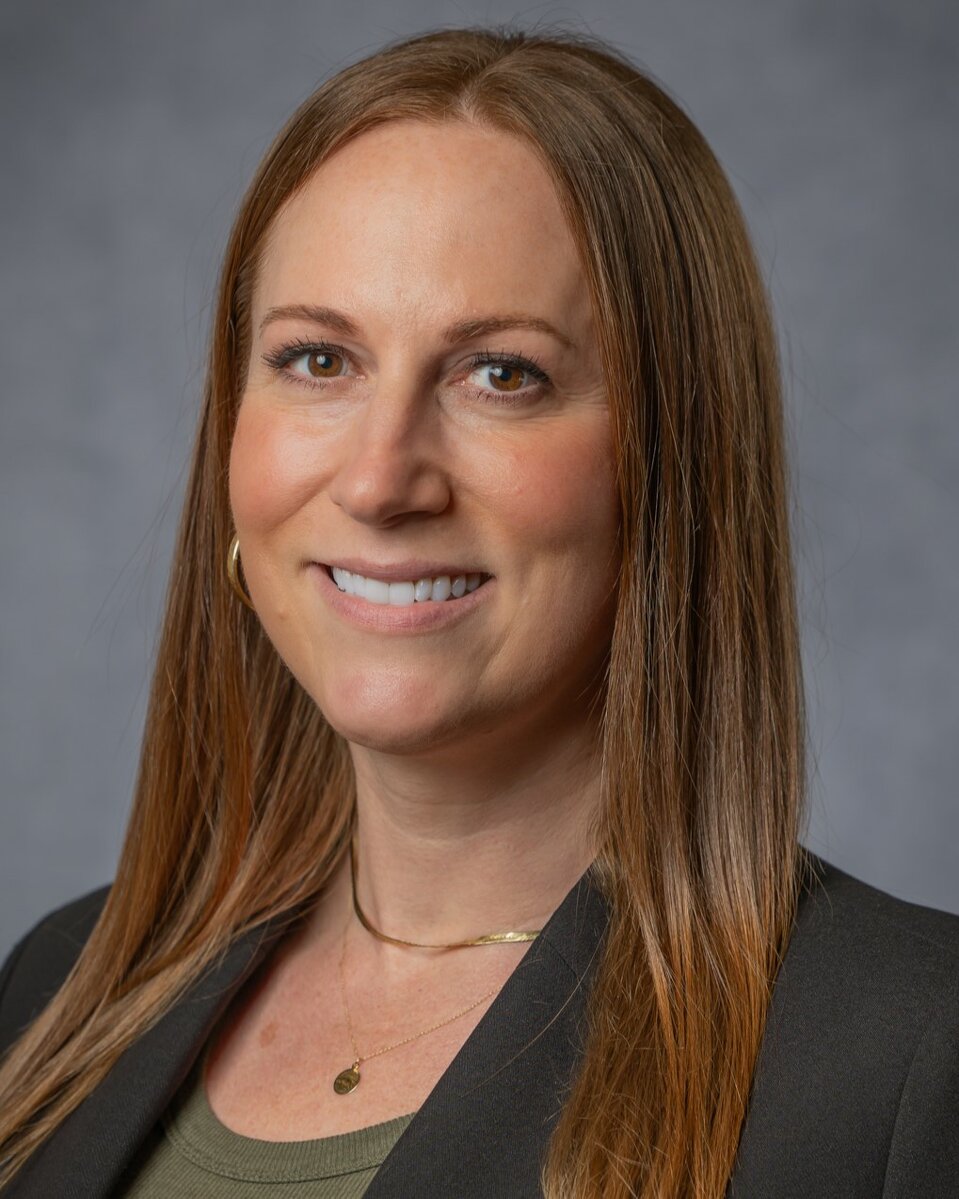 Michelle C. Arnett, MS, RDH, currently serves as an Associate Professor in the Department of Primary Dental Care, Division of Dental Hygiene at the University of Minnesota (UMN) School of Dentistry (SOD). She has 20 years of clinical practice experience and nine years of experience in academics and research at the University of Michigan SOD and the UMN SOD. Her areas of research focus are motivational interviewing and periodontology. In addition to topics to enhance her teaching, student mentorship, and dental hygiene educator burnout. Michelle has taught Communications, Periodontology, and the Process of Care in Allied Oral Health: Clinical Application III and currently teaches Process of Care in Allied Oral Health: Clinical Application IV in the UMN SOD dental hygiene undergraduate program and Thesis I, II and the Capstone Track (I-IV) in the UMN dental hygiene graduate program. Her professional memberships include Sigma Phi Alpha-Nu Chapter, American Dental Hygienists’ Association (ADHA), and the American Dental Education Association (ADEA).
Michelle C. Arnett, MS, RDH, currently serves as an Associate Professor in the Department of Primary Dental Care, Division of Dental Hygiene at the University of Minnesota (UMN) School of Dentistry (SOD). She has 20 years of clinical practice experience and nine years of experience in academics and research at the University of Michigan SOD and the UMN SOD. Her areas of research focus are motivational interviewing and periodontology. In addition to topics to enhance her teaching, student mentorship, and dental hygiene educator burnout. Michelle has taught Communications, Periodontology, and the Process of Care in Allied Oral Health: Clinical Application III and currently teaches Process of Care in Allied Oral Health: Clinical Application IV in the UMN SOD dental hygiene undergraduate program and Thesis I, II and the Capstone Track (I-IV) in the UMN dental hygiene graduate program. Her professional memberships include Sigma Phi Alpha-Nu Chapter, American Dental Hygienists’ Association (ADHA), and the American Dental Education Association (ADEA).
 Yvette Reibel, EdD, LDH, currently serves as an Assistant Professor in the Department of Primary Dental Care, Division of Dental Hygiene at the University of Minnesota (UMN) School of Dentistry (SOD). She has 20 years of clinical practice experience and nine years of experience in academics and research at the UMN SOD. Her areas of research focus are obstructive sleep apnea, curriculum development and assessment. Yvette has taught Dental Hygiene Preclinic and the Process of Care in Allied Oral Health: Clinical Application II and currently teaches Pharmacology, Research Methods, and Process of Care in Allied Oral Health: Clinical Application VI Capstone in the UMN SOD dental hygiene undergraduate program and Curriculum Development and Design, Didactic Student Teaching, Clinicals Administration, and Thesis III: Data Analysis in the UMN dental hygiene graduate program in addition to being the program director.
Yvette Reibel, EdD, LDH, currently serves as an Assistant Professor in the Department of Primary Dental Care, Division of Dental Hygiene at the University of Minnesota (UMN) School of Dentistry (SOD). She has 20 years of clinical practice experience and nine years of experience in academics and research at the UMN SOD. Her areas of research focus are obstructive sleep apnea, curriculum development and assessment. Yvette has taught Dental Hygiene Preclinic and the Process of Care in Allied Oral Health: Clinical Application II and currently teaches Pharmacology, Research Methods, and Process of Care in Allied Oral Health: Clinical Application VI Capstone in the UMN SOD dental hygiene undergraduate program and Curriculum Development and Design, Didactic Student Teaching, Clinicals Administration, and Thesis III: Data Analysis in the UMN dental hygiene graduate program in addition to being the program director.
